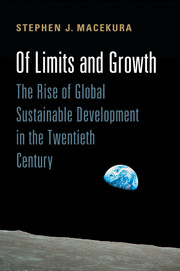Book contents
- Frontmatter
- Contents
- List of Illustrations
- Acknowledgments
- Introduction: NGOs and the Origins of “Sustainable Development”
- PART ONE ORIGINS
- PART TWO REFORMS
- PART THREE PERSISTENT PROBLEMS
- 7 The Persistence of Old Problems: The Politics of Environment and Development at the Rio Earth Summit
- Conclusion: The Growth and Limits of NGOs
- Archives
- Index
7 - The Persistence of Old Problems: The Politics of Environment and Development at the Rio Earth Summit
from PART THREE - PERSISTENT PROBLEMS
Published online by Cambridge University Press: 05 July 2015
- Frontmatter
- Contents
- List of Illustrations
- Acknowledgments
- Introduction: NGOs and the Origins of “Sustainable Development”
- PART ONE ORIGINS
- PART TWO REFORMS
- PART THREE PERSISTENT PROBLEMS
- 7 The Persistence of Old Problems: The Politics of Environment and Development at the Rio Earth Summit
- Conclusion: The Growth and Limits of NGOs
- Archives
- Index
Summary
Standing before exasperated delegates on June 12, 1992, at the United Nations Conference on Environment and Development (UNCED) in Rio de Janeiro, President George H. W. Bush spoke in vague terms. “We believe that the road to Rio must point toward both environmental protection and economic growth, environment and development,” the president proclaimed. “By now it's clear: To sustain development, we must protect the environment. And to protect the environment, we must sustain development.”
President Bush's words left many onlookers baffled. On the one hand, Bush spoke the language of sustainability, noting the interrelationship between economic development and environmental protection. Soon after his speech, the president signed the conference's formal declaration, which proclaimed “sustainable development” as the discursive framework for the United Nations' development policies. He acknowledged the need to integrate environmental protection into all economic development policies. On the other hand, President Bush did not attempt to describe exactly how that process would occur. He also rejected many of the formal conventions on the table in Rio. The president refused to sign a treaty on biodiversity protection, and he only agreed to support an agreement on global climate change that came without any binding stipulations. Although the president had accepted the necessity of crafting environmentally friendly approaches to development, it was clear that full cooperation and significant concrete measures remained out of reach.
The gulf between the president's rhetoric and actions revealed two salient aspects of how the relationship between environmentalism and economic development had evolved over the previous decades. As President Bush's speech indicated, the conference legitimized the use of sustainability rhetoric to acknowledge the link between environmental protection and economic development, which major environmental nongovernmental organizations (NGOs) had been promoting for over a decade. In the immediate aftermath of World War II, many policy makers conceived of environmental protection and economic policy as separate policy domains; by 1992, every government leader acknowledged the interconnectedness of the two concepts and every leader spoke of “sustainable development.” In some respects, NGOs such as the International Union for the Conservation of Nature (IUCN) and the World Wildlife Fund (WWF) had succeeded beyond their expectations in popularizing the sustainability concept.
- Type
- Chapter
- Information
- Of Limits and GrowthThe Rise of Global Sustainable Development in the Twentieth Century, pp. 261 - 303Publisher: Cambridge University PressPrint publication year: 2015

